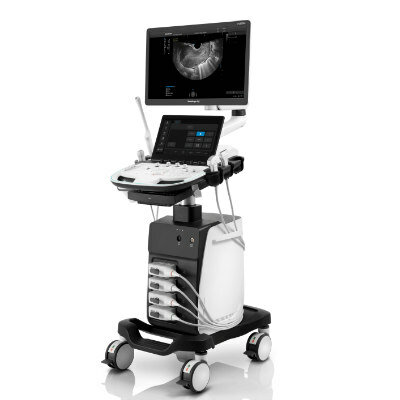New Molecular Imaging Test to Improve Lung Cancer Diagnosis
|
By MedImaging International staff writers Posted on 07 Mar 2025 |

Lung cancer continues to be one of the leading causes of cancer-related deaths, primarily because it often goes undetected until it reaches more advanced and aggressive stages. Panitumumab, a humanized antibody used in cancer treatment, targets the epidermal growth factor receptor (EGFR), which is present on the surface of many cancer cells. This receptor is especially abundant in non-small-cell lung cancer, making it a prime target for anti-cancer therapies. Copper-64, a radioactive isotope, is used in positron emission tomography (PET) scans. Now, by combining panitumumab with copper-64, researchers and clinicians can more accurately locate and track tumors and better monitor the effectiveness of treatments.
A team of researchers from the University of Alberta (Edmonton, Canada) has developed a new molecular imaging technique that could improve the detection of lung cancer and offer enhanced monitoring of treatment progress. By pairing panitumumab with copper-64, this new method combines the antibody's precision targeting capability with the exceptional sensitivity of radioisotope detection, providing a tool for earlier and more accurate detection of lung cancer, as well as monitoring treatment responses. Copper-64, when linked to panitumumab, enables clinicians and researchers to track the "metabolic fate" of the antibody, including its accumulation and retention in cancer cells. To evaluate this imaging agent, the team used several preclinical lung cancer models in mice, including a metastasis model to identify lung cancer lesions in distant organs such as the liver. The study, published in Molecular Pharmaceutics, revealed that this imaging technique not only highlights tumors in the lungs but also identifies metastatic tumors in the liver.
This dual capability of detecting both primary and metastatic tumors while providing crucial molecular data about the cancer cells overcomes significant limitations of traditional diagnostic imaging techniques. For example, CT scans often miss smaller tumors or those located in challenging areas like soft tissues, and they do not offer molecular insights into cancer cells. The new PET imaging test can also serve as a valuable tool for tracking cancer growth and metastasis over time. The research team plans to explore further the combination of panitumumab with copper-67, a complementary isotope that can deliver targeted radiation to kill cancer cells. When paired together, panitumumab and copper-67 could locate and destroy cancerous cells while sparing surrounding healthy tissues. The researchers also suggest that other antibody therapies could be combined with radioisotopes, such as copper-64 and copper-67, to improve the detection and treatment of cancer, ultimately advancing patient care and outcomes.
“Instead of exposing the patient to an invasive biopsy, they can go and get an injection, and then we can use a PET scan to help see the tumor and help physicians to determine the best course of therapy,” said study co-author Afsaneh Lavasanifar.
“With our tools, imaging biomarkers like radiolabeled panitumumab and non-invasive PET imaging technology, we can provide valuable information to clinicians about the molecular footprint of cancer cells,” added Frank Wuest, oncology professor in the Faculty of Medicine & Dentistry.
Latest Nuclear Medicine News
- Novel Bacteria-Specific PET Imaging Approach Detects Hard-To-Diagnose Lung Infections
- New Imaging Approach Could Reduce Need for Biopsies to Monitor Prostate Cancer
- Novel Radiolabeled Antibody Improves Diagnosis and Treatment of Solid Tumors
- Novel PET Imaging Approach Offers Never-Before-Seen View of Neuroinflammation
- Novel Radiotracer Identifies Biomarker for Triple-Negative Breast Cancer
- Innovative PET Imaging Technique to Help Diagnose Neurodegeneration
- Novel PET Technique Visualizes Spinal Cord Injuries to Predict Recovery
- Next-Gen Tau Radiotracers Outperform FDA-Approved Imaging Agents in Detecting Alzheimer’s
- Breakthrough Method Detects Inflammation in Body Using PET Imaging
- Advanced Imaging Reveals Hidden Metastases in High-Risk Prostate Cancer Patients
- Combining Advanced Imaging Technologies Offers Breakthrough in Glioblastoma Treatment
- New Molecular Imaging Agent Accurately Identifies Crucial Cancer Biomarker
- New Scans Light Up Aggressive Tumors for Better Treatment
- AI Stroke Brain Scan Readings Twice as Accurate as Current Method
- AI Analysis of PET/CT Images Predicts Side Effects of Immunotherapy in Lung Cancer
- New Imaging Agent to Drive Step-Change for Brain Cancer Imaging
Channels
Radiography
view channel
AI Detects Fatty Liver Disease from Chest X-Rays
Fatty liver disease, which results from excess fat accumulation in the liver, is believed to impact approximately one in four individuals globally. If not addressed in time, it can progress to severe conditions... Read more
AI Detects Hidden Heart Disease in Existing CT Chest Scans
Coronary artery calcium (CAC) is a major indicator of cardiovascular risk, but its assessment typically requires a specialized “gated” CT scan that synchronizes with the heartbeat. In contrast, most chest... Read moreMRI
view channel
New MRI Technique Reveals Hidden Heart Issues
Traditional exercise stress tests conducted within an MRI machine require patients to lie flat, a position that artificially improves heart function by increasing stroke volume due to gravity-driven blood... Read more
Shorter MRI Exam Effectively Detects Cancer in Dense Breasts
Women with extremely dense breasts face a higher risk of missed breast cancer diagnoses, as dense glandular and fibrous tissue can obscure tumors on mammograms. While breast MRI is recommended for supplemental... Read moreUltrasound
view channel
Wireless Chronic Pain Management Device to Reduce Need for Painkillers and Surgery
Chronic pain affects millions of people globally, often leading to long-term disability and dependence on opioid medications, which carry significant risks of side effects and addiction.... Read more
New Medical Ultrasound Imaging Technique Enables ICU Bedside Monitoring
Ultrasound computed tomography (USCT) presents a safer alternative to imaging techniques like X-ray computed tomography (commonly known as CT or “CAT” scans) because it does not produce ionizing radiation.... Read moreGeneral/Advanced Imaging
view channel
CT Colonography Beats Stool DNA Testing for Colon Cancer Screening
As colorectal cancer remains the second leading cause of cancer-related deaths worldwide, early detection through screening is vital to reduce advanced-stage treatments and associated costs.... Read more
First-Of-Its-Kind Wearable Device Offers Revolutionary Alternative to CT Scans
Currently, patients with conditions such as heart failure, pneumonia, or respiratory distress often require multiple imaging procedures that are intermittent, disruptive, and involve high levels of radiation.... Read more
AI-Based CT Scan Analysis Predicts Early-Stage Kidney Damage Due to Cancer Treatments
Radioligand therapy, a form of targeted nuclear medicine, has recently gained attention for its potential in treating specific types of tumors. However, one of the potential side effects of this therapy... Read moreImaging IT
view channel
New Google Cloud Medical Imaging Suite Makes Imaging Healthcare Data More Accessible
Medical imaging is a critical tool used to diagnose patients, and there are billions of medical images scanned globally each year. Imaging data accounts for about 90% of all healthcare data1 and, until... Read more
Global AI in Medical Diagnostics Market to Be Driven by Demand for Image Recognition in Radiology
The global artificial intelligence (AI) in medical diagnostics market is expanding with early disease detection being one of its key applications and image recognition becoming a compelling consumer proposition... Read moreIndustry News
view channel
GE HealthCare and NVIDIA Collaboration to Reimagine Diagnostic Imaging
GE HealthCare (Chicago, IL, USA) has entered into a collaboration with NVIDIA (Santa Clara, CA, USA), expanding the existing relationship between the two companies to focus on pioneering innovation in... Read more
Patient-Specific 3D-Printed Phantoms Transform CT Imaging
New research has highlighted how anatomically precise, patient-specific 3D-printed phantoms are proving to be scalable, cost-effective, and efficient tools in the development of new CT scan algorithms... Read more
Siemens and Sectra Collaborate on Enhancing Radiology Workflows
Siemens Healthineers (Forchheim, Germany) and Sectra (Linköping, Sweden) have entered into a collaboration aimed at enhancing radiologists' diagnostic capabilities and, in turn, improving patient care... Read more

















.jpeg)


